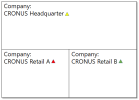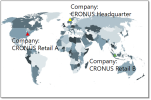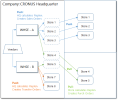


Replenishment can be run with one or multiple Business Central companies within one database.
There are 3 main models:
- Single company
- Multiple companies - HQ driven
- Multiple companies - store driven
These scenarios can be combined into a mixed model. Mixed models usually occur if a retailer operates stores in his supply chain company and also in sales companies.
For mixed models it is important to identify on location level, if the location is replenished by the supply chain company or if it is responsible for it's own replenishment.
Key questions / considerations
Questions (for each store)
- Resides the store in the supply chain company?
- If yes:
- Use single company approach and setup
- Store and location exist in supply chain company only
- If no:
- Is the supply chain company calculating replenishment for the store and pushes items to the sales company's store
- If yes:
- Use multi company (HQ driven) approach
- Store and location exist in both companies (with same names)
- Supply chain company calculates Replen. Transfer Journals (Sales Orders)
- Supply chain company pushes items to store
- If no:
- Use Multi company (store driven) approach
- Store and location exist in both companies (with same names)
- Sales company calculates Replen. Purchase Journals (Purchase Orders)
- Sales company pulls items to store
- If yes:
- Is the supply chain company calculating replenishment for the store and pushes items to the sales company's store
- If yes:
For each store and location we need to understand, how the sourcing is done and then the locations in the supply chain company and sales companies have to be set up accordingly.
Output
Topology drawing

Setup considerations
See setup considerations in:
Replenishment Calculation
LS Replenishment support scenarios, where the above 3 models can be combined.
To achieve this, replenishment is run in the following steps:
Sales companies
- The Replenishment Item Quantity is calculated in each of the sales companies.
- With this, the sales company is equipped with the sales and demand information in the sales companies, enabling it to:
- Calculate Replenishment Journals to propose Purchase Orders (against the supply chain company)
Supply Chain company
- The Replenishment Item Quantity is calculated in the central supply chain company, and the pre-calculated Replenishment Item Quantity data from the sales companies will be copied to the supply chain company.
- With this, the supply chain company is equipped with the sales and demand information in the sales companies, enabling it to:
- Replen. Purchase Journals
- Calculate Replenishment Journals to propose Purchase Orders (against vendors)
- Replen. Transfer Journals
- for stores in HQ company:
- Calculate Replenishment Journals to propose Transfer Orders to replenish the stores in the HQ company
- for stores in sales company (HQ driven):
- Calculate Replenishment Journals to propose Sales Orders to replenish the sales companies, where replenishment is HQ driven
- for stores in sales company (Store driven):
- Since this is covered in the sales company, the HQ does not calculate any proposals to replenish the stores
- for stores in HQ company:
- Replen. Purchase Journals
Replenishment Templates
In a mixed model with HQ driven stores and store driven stores it is important to split Replenishment Templates to run those separately.
Go back to:



